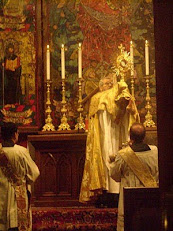Mr. Uher writes:
Many Episcopalians and Anglicans, present and former, still recall with great affection the Deaconesses in their lives. We recall some of them in their distinctive cap or distinctive cross. Some of us recall a Deaconess dressed like a nun in a voluminous black or grey habit. Today some will know them in a distinctive blue cassock with blue cincture. When the Episcopalian Church in the USA decided to ordain women to the diaconate, the Deaconesses all but disappeared. Since 2002 the Order of Deaconesses has been established canonically among the Reformed Episcopalians where the Deaconesses provide many forms of help including performing baptisms when no deacon or priest is available. Deaconesses continue to serve in other parts of the Anglican Communion. The duties of the Deaconess in the various Anglican Churches did indeed vary, but behind all interpretations was a desire for the Deaconess to be in the local church as St. Phoebe was in Sacred Scripture, an idea at the heart of the setting apart of Deaconess Elizabeth Catherine Ferard in the Church of England as the first Deaconess of that Church. Deaconess Isabella Gilmore in the Diocese of Rochester, England explored a different model for the life of the Deaconess that was very influential. And among the many Deaconesses, the first African-American Deaconess in the state of Georgia in the USA is venerated as one of sainted memory: Deaconess Anna E.B. Alexander...Please visit his site and enjoy not only the history by the photos of notable women who dedicated their lives to the service of Christ and his followers.














I have always supported the idea of the OFFICE OF DEACONESS. I only met 1 Episcopalian Deaconess at the old Episcopal Cathedral in the late 60's. She was a wonderful woman to talk to, in her 50's I think. In 1970 when I returned to college after my service in the USAF I had the pleasure to make the acquaintance of a group of Lutheran Deaconesses who were taking classes. The hung out with a group of Franciscan Sisters who were also taking in classes. Truly ecumenical fun. I have no problem with the OFFICE of Deaconess as long as their duties (gleaned from all around the world) is specified and enforced.
ReplyDeleteWhen the Episcopalian Church in the USA decided to ordain women to the diaconate, the Deaconesses all but disappeared.
ReplyDeleteThis sentence should be rephrased: When the Episcopal Church in the USA decided to ordain women to the priesthood, the Deaconesses all but disappeared